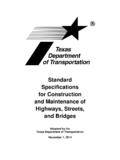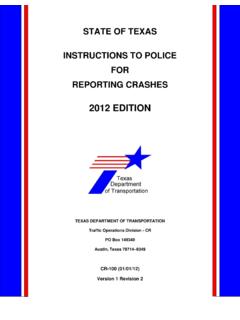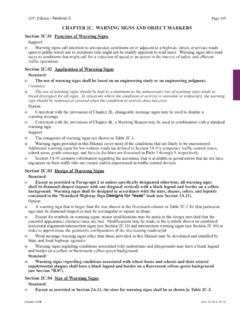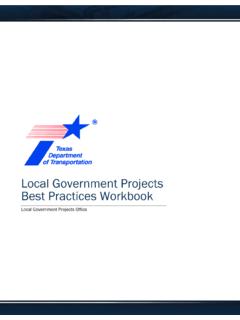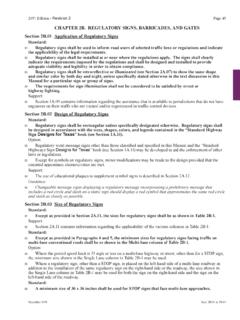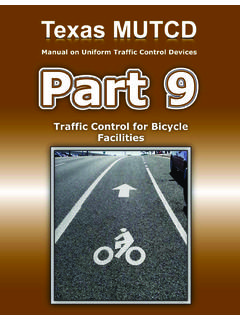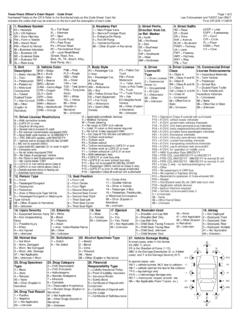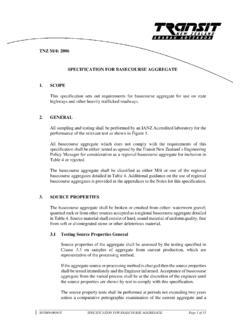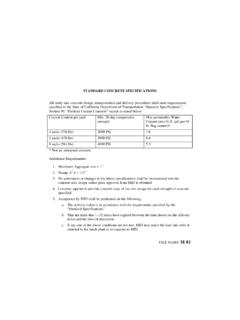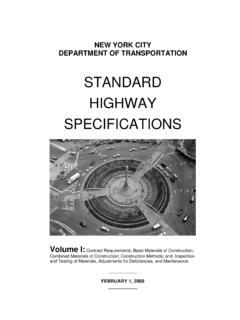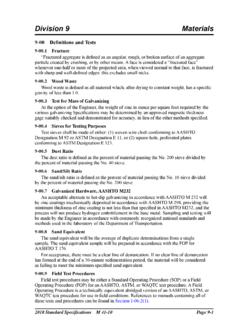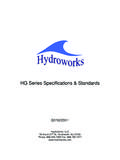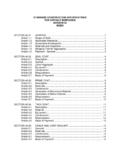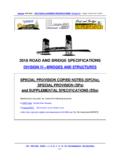Transcription of FLEXIBLE BASE 247.1. 247.2. A. Aggregate. Table 1 …
1 ITEM 247 FLEXIBLE BASE Description. Construct a foundation course composed of FLEXIBLE base. Materials. Furnish uncontaminated materials of uniform quality that meet the requirements of the plans and specifications. Notify the Engineer of the proposed material sources and of changes to material sources. The Engineer may sample and test project materials at any time before compaction throughout the duration of the project to assure specification compliance. Use Tex-100-E material definitions. A. aggregate . Furnish aggregate of the type and grade shown on the plans and conforming to the requirements of Table 1.
2 Each source must meet Table 1 requirements for liquid limit, plasticity index, and wet ball mill for the grade specified. Do not use additives such as but not limited to lime, cement, or fly ash to modify aggregates to meet the requirements of Table 1, unless shown on the plans. Table 1 Material requirements Property Test Method Grade 1 Grade 2 Grade 3 Grade 4 Master gradation sieve size (% retained) 2-1/2 in. 0 0 1-3/4 in. 0 0 10 0 10 7/8 in. 10 35 3/8 in. 30 50 No. 4 45 65 45 75 45 75 No. 40 Tex-110-E 70 85 60 85 50 85 As shown on the plans Liquid limit, % Tex-104-E 35 40 40 As shown on the plans Plasticity index, 10 12 12 As shown on the plans Plasticity index, Tex-106-E As shown on the plans Wet ball mill.
3 % 40 45 Wet ball mill, % max. increase passing the No. 40 sieve Tex-116-E 20 20 As shown on the plans Classification3 As shown on the plans Min. compressive strength3, psi lateral pressure 0 psi 45 35 lateral pressure 15 psi Tex-117-E 175 175 As shown on the plans 1.
4 Determine plastic index in accordance with Tex-107-E (linear shrinkage) when liquid limit is unattainable as defined in Tex-104-E. 2. When a soundness value is required by the plans, test material in accordance with Tex-411-A. 3. Meet both the classification and the minimum compressive strength, unless otherwise shown on the plans. 1. Material Tolerances. The Engineer may accept material if no more than 1 of the 5 most recent gradation tests has an individual sieve outside the specified limits of the gradation. When target grading is required by the plans, no single failing test may exceed the master grading by more than 5 percentage points on sieves No.
5 4 and larger or 3 percentage points on sieves smaller than No. 4. The Engineer may accept material if no more than 1 of the 5 most recent plasticity index tests is outside the specified limit. No single failing test may exceed the allowable limit by more than 2 points. 2. Material Types. Do not use fillers or binders unless approved. Furnish the type specified on the plans in accordance with the following. a. Type A. Crushed stone produced and graded from oversize quarried aggregate that originates from a single, naturally occurring source.
6 Do not use gravel or multiple sources. b. Type B. Crushed or uncrushed gravel. Blending of 2 or more sources is allowed. c. Type C. Crushed gravel with a minimum of 60% of the particles retained on a No. 4 sieve with 2 or more crushed faces as determined by Tex-460-A, Part I. Blending of 2 or more sources is allowed. d. Type D. Type A material or crushed concrete. Crushed concrete containing gravel will be considered Type D material. Crushed concrete must meet the requirements in Section , Recycled Material (Including Crushed Concrete) requirements , and be managed in a way to provide for uniform quality.
7 The Engineer may require separate dedicated stockpiles in order to verify compliance. e. Type E. As shown on the plans. 3. Recycled Material. Recycled asphalt pavement (RAP) and other recycled materials may be used when shown on the plans. Request approval to blend 2 or more sources of recycled materials. a. Limits on Percentage. When RAP is allowed, do not exceed 20% RAP by weight unless otherwise shown on the plans. The percentage limitations for other recycled materials will be as shown on the plans. b. Recycled Material (Including Crushed Concrete) requirements .
8 (1) Contractor Furnished Recycled Materials. When the Contractor furnishes the recycled materials, including crushed concrete, the final product will be subject to the requirements of Table 1 for the grade specified. Certify compliance with DMS-11000, Evaluating and Using Nonhazardous Recyclable Materials Guidelines, for Contractor furnished recycled materials. In addition, recycled materials must be free from reinforcing steel and other objectionable material and have at most deleterious material when tested in accordance with Tex-413-A.
9 For RAP, do not exceed a maximum percent loss from decantation of when tested in accordance with Tex-406-A. Test RAP without removing the asphalt. (2) Department Furnished Required Recycled Materials. When the Department furnishes and requires the use of recycled materials, unless otherwise shown on the plans: Department required recycled material will not be subject to the requirements in Table 1, Contractor furnished materials are subject to the requirements in Table 1 and this Item, the final product, blended, will be subject to the requirements in Table 1, and for final product, unblended (100% Department furnished required recycled material), the liquid limit, plasticity index, wet ball mill, classification, and compressive strength is waived.
10 Crush Department-furnished RAP so that 100% passes the 2 in. sieve. The Contractor is responsible for uniformly blending to meet the percentage required. (3) Department Furnished and Allowed Recycled Materials. When the Department furnishes and allows the use of recycled materials or allows the Contractor to furnish recycled materials, the final blended product is subject to the requirements of Table 1 and the plans. c. Recycled Material Sources. Department-owned recycled material is available to the Contractor only when shown on the plans.
